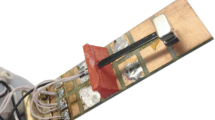Abstract
A magnetoelectric sensor with the highest currently known quasi-static magnetoelectric coefficient, 92 V/(cm Oe), is theoretically described. A model is suggested based on which the optimal thickness of piezoceramics providing the highest generated voltage is determined. The influence of the Maxwell-Wagner relaxation and effective parameter approximation on the physical properties of hybrid structures is studied for the first time. The theoretical and experimental data are compared with models that consider the transformed cross section method as a main technique for determining the equivalent stiffness of the structure.
Similar content being viewed by others
References
C.-W. Nan, M. I. Bichurin, S. Dong, et al., J. Appl. Phys. 103, 031101 (2008).
D. A. Filippov, T. A. Galkina, V. M. Laletin, et al., Tech. Phys. Lett. 38, 93 (2012).
D. A. Filippov, Phys. Solid State 54, 1182 (2012).
G. Liu, X. Li, J. Chen, et al., Appl. Phys. Lett. 101, 142904 (2012).
G. Smits Jan, S. I. Dalke, and T. K. Cooney, Sens. Actuators A 28, 41 (1991).
Q.-M. Wang, X.-H. Du, B. Xu, and L. E. Cross, J. Appl. Phys. 85, 1702 (1999).
T. T. Nguyen, F. Bouillault, L. Daniel, and H. Mininger, J. Appl. Phys. 109, 081904 (2011).
V. I. Feodos’ev, Strength of Materials (Mir, Moscow, 1968).
V. M. Petrov, G. Srinivasan, and M. I. Bichurin, J. Appl. Phys. 105, 063911 (2009).
Q.-M. Wang and L. E. Cross, Ferroelectrics 215, 187 (1998).
V. M. Petrov, M. I. Bichurin, and G. Srinivasan, Tech. Phys. Lett. 30, 6 (2004).
A. V. Turik and G. S. Radchenko, J. Phys. D: Appl. Phys. 35, 1188 (2002).
N. Wu, Q. Wang, and S. T. Quek, J. Sound Vib. 329, 1126 (2010).
Author information
Authors and Affiliations
Corresponding author
Additional information
Original Russian Text © G.S. Radchenko, M.G. Radchenko, 2014, published in Zhurnal Tekhnicheskoi Fiziki, 2014, Vol. 84, No. 10, pp. 39–43.
Rights and permissions
About this article
Cite this article
Radchenko, G.S., Radchenko, M.G. Magnet-metal-piezoelectric magnetic sensor with the highest magnetoelectric coefficient. Tech. Phys. 59, 1457–1461 (2014). https://doi.org/10.1134/S1063784214100259
Received:
Published:
Issue Date:
DOI: https://doi.org/10.1134/S1063784214100259




